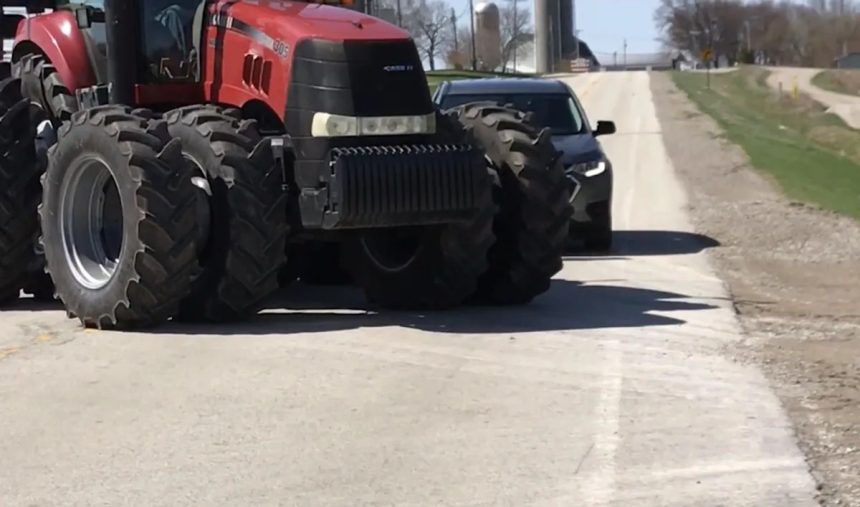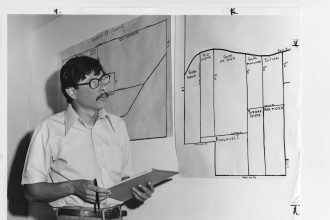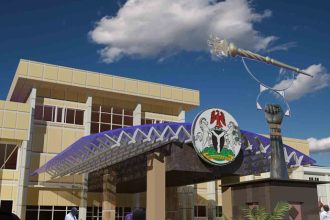Autumn signals many changes in rural Wisconsin: cooler temperatures, shorter daylight hours and an uptick in farm machinery traffic as farmers harvest this year’s crops and prepare fields for winter.
As large pieces of farm equipment move in and out of fields, motorists may find themselves following slow-moving agricultural machinery as it bounces down the road, heading from one field to another.
Wisconsin Farm Bureau President Brad Olson says fall harvest time can be one of the busiest and most dangerous seasons of the year for those involved in agriculture.
“All motorists share the goal of returning home safe to their families,” Olson said. “During this time of year, it is important to take extra precautions and pay careful attention to increased hazards on rural roadways.”
A tractor pulling a self-unloading forage wagon heads to a cornfield during harvesttime.
Speed and inattentive driving are dangerous
Roadway crashes are the leading cause of injuries and death in agriculture. Last year, the Wisconsin Department of Transportation reported 153 crashes involving farm vehicles. Speed and inattentive driving are often cited as the cause of crashes between farm machinery and drivers.
A 20-year-old Coloma woman narrowly avoided becoming a fatality last fall when she collided with a potato harvester being towed by a tractor on I-39 in Portage County. According to police reports, Hannah Borud was traveling at 75 mph around 1 p.m. when she attempted to swerve before striking the machinery. The driver of the tractor was traveling at 26 mph at the time of impact. Borud, who was injured, said she never saw the equipment.
During a recent presentation he gave for National Farm Safety & Health Week, John Shutske, agricultural safety and health specialist at the University of Wisconsin-Madison says crashes between vehicles and farm equipment can happen in only a matter of seconds.

As harvest season starts to ramp up, rural byways see an uptick in traffic, making encounters between motorists and farm vehicles inevitable – and sometimes dangerous.
The difference in speeds between a vehicle traveling at highway speeds following a tractor pulling two 250-bushel gravity boxes moving 18 mph doesn’t give the driver much time to react.
“The SUV is approaching the back of a 27-ton train at a “relative” speed of 54.3 feet per second. In this ideal case, we have 600 feet/54.3 ft. per second or around 11 seconds (to react and take action),” Shutske says. “If I glance at a text, I burn up 200 feet.”
Add in factors that limit visibility, such as curves and hills, or environmental factors like rain, fog and glare from the rising or setting sun, and the time to avoid a serious crash has nearly disappeared.
The Polk County Sheriff’s Office received a call at 5:18 a.m. on Sept. 25, 2024, of a crash on State 63 near Clear Lake involving an SUV and a farm tractor. Traveling in dense fog, the SUV driver died after hitting the back of the tractor.
Most motorists are unaware of the physics involved in stopping a tractor pulling a loaded grain cart that can weigh upwards of 50,000 pounds. Although the machinery is moving at slower speeds, it requires a greater stopping distance.

Wide equipment operators are required by law to yield the opposite lane to oncoming traffic to maintain traffic flow and safety.
Since 2014, it has been illegal to pass farm equipment in a no-passing zone, regardless of speed. Motorists must wait until they enter a legal passing zone and can safely pass. Wide equipment operators are required by law to yield the opposite lane to oncoming traffic to maintain traffic flow and safety.
Even if a motorist can legally pass a large piece of equipment within a very short distance of a controlled intersection, the action itself has a dramatic impact on the reaction time of the farm equipment operator, according to WFBF.
How to make sure motorists can see your farm equipment
Required lighting for farm machinery built since 2017 is based on the voluntary ANSI/ASAE S279 standard, which was adopted by the federal government and applies to tractors, self-propelled equipment, and implements; this lighting includes headlights and taillights, flashing amber lights, reflectors, and side-marking tape. Shutske says older equipment should be upgraded and encourages farmers to use inexpensive lighting kits that can be affixed with clamps or magnets. Side marking tape also increases visibility.
Wisconsin has lighting and marking requirements for all Implements of Husbandry (IoH). Self-propelled IoH and farm equipment exceeding 12 feet wide or that extend over the center of the roadway have specific lighting and marking requirements. This is to ensure the safety of IoH operators and other traffic on the road.

A line of tankers line up along Lost Arrow Road to deliver a load of liquid manure to a dump transfer station that provides manure for a dragline system
Larger farm operations may present additional challenges
As farming operations expand and require more land to grow crops and spread manure, the equipment must also travel longer distances during harvest. Motorists may encounter a steady stream of large self-unloading forage wagons as well as manure tankers. Some tankers may spread manure directly on the fields, while other farmers may set up dump transfer stations along the road to provide manure for a dragline system. Drivers should pay special attention to manure tankers traveling to and from the site.
“Farmers and motorists share the responsibility of ensuring roadway safety. Attentiveness is a constant requirement on the road, but being prepared and exercising caution during peak times is vital to a successful harvest,” Olson said. “At the end of a long, hard workday, everyone deserves to return home safely.”
This article originally appeared on Wisconsin State Farmer: Wisconsin farmers, drivers at risk for crashes during fall harvest









